Odyssey
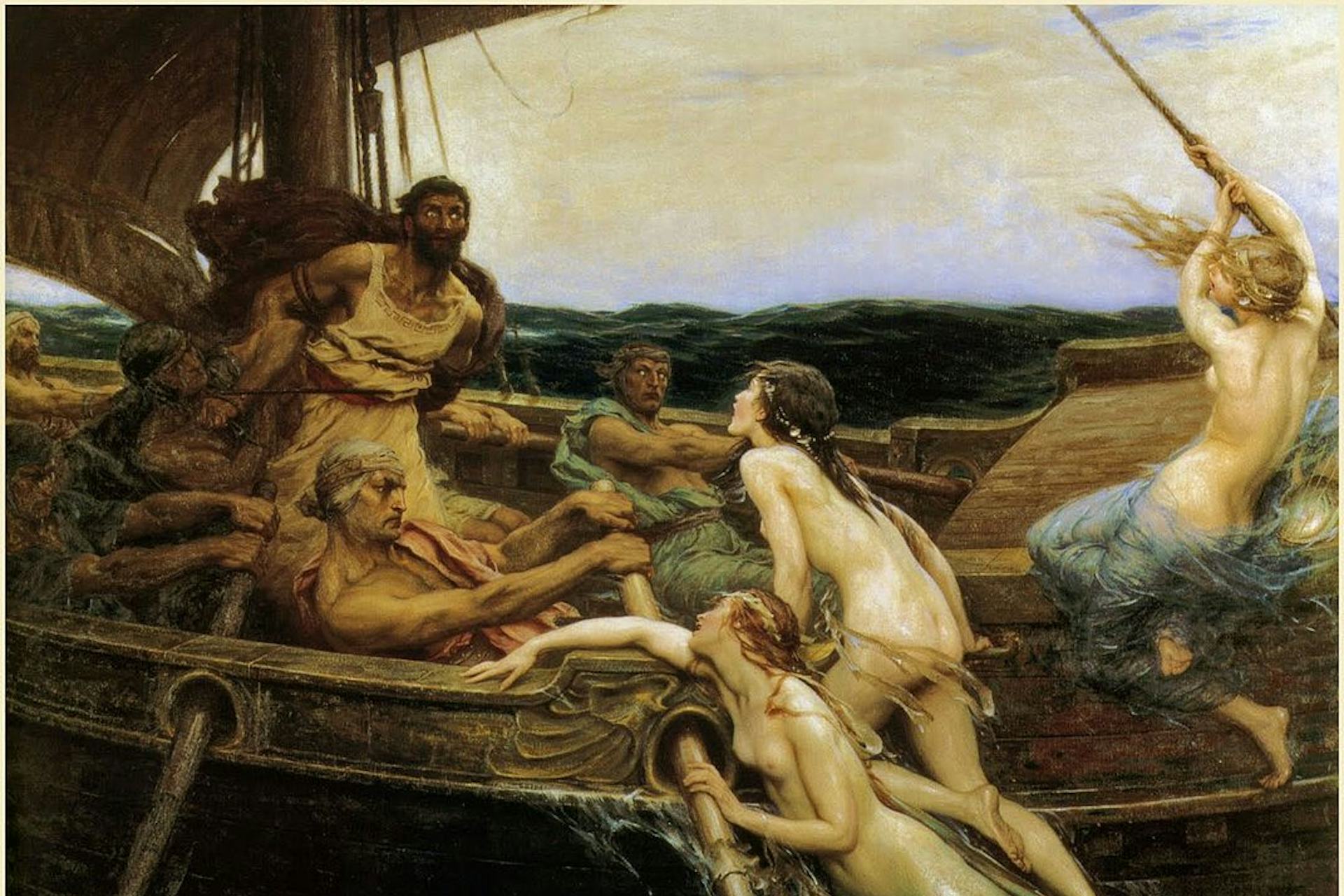
Ulysses and the Sirens by Herbert James Draper (ca. 1909)
Ferens Art Gallery, HullPublic DomainOverview
The Odyssey—an epic poem made up of 24 books—is one of the earliest works of ancient Greek literature. Together with the Iliad, it is one of two epics said to have been written by Homer, a Greek poet of quasi-mythical status. The Odyssey was probably composed around 750–700 BCE, shortly after the Iliad.
The Odyssey takes place after the end of the Trojan War, a decade-long conflict in which the “Achaean” heroes of Greece attacked and sacked the city of Troy. The poem narrates the wanderings of the Greek hero Odysseus, the “man of twists and turns,” as he journeys home to his island kingdom of Ithaca after fighting at Troy.
Odysseus’ tale of tumultuous seas, terrifying monsters, and angry gods is interwoven with a parallel narrative set in Ithaca, in which Odysseus’ wife Penelope and his son Telemachus must fend off an army of boorish suitors vying for Penelope’s hand in marriage.
To this day, the Odyssey is still considered one of the most important works of Western literature, exerting a significant influence on scholarship, the arts, and popular culture.
Title
The title “Odyssey” (Greek Ὀδύσσεια or, more rarely, Ὀδυσσείη, translit. Odysseia or Odysseiē) is a feminine adjective derived from Odysseus’ name. It thus means “Odyssean” or “of Odysseus.” We can imagine the hypothetical full title of the poem as being Ὀδύσσεια ποίησις (Odysseia poiēsis), that is, “poem of Odysseus.”
Pronunciation
English
Greek
Odyssey Ὀδύσσεια (translit. Odysseia) Phonetic
IPA
[OD-uh-see] /ˈɒd ə si/
Author
We know nothing (possibly less than nothing) about Homer, the name traditionally given to the author of the Iliad and the Odyssey.
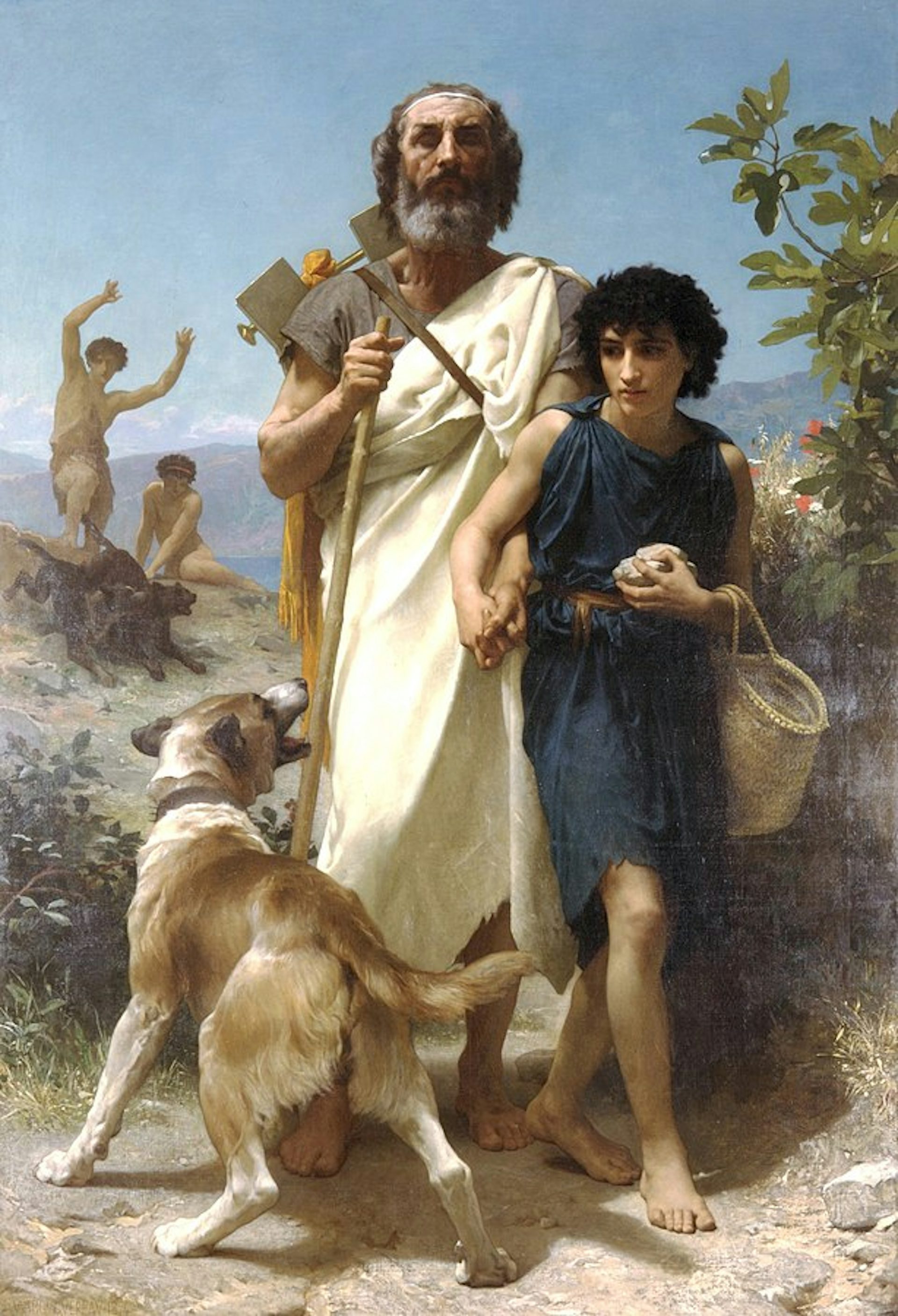
Homer and his Guide by William Adolphe Bougueraeu (1874)
Milwaukee Art Museum, Milwaukee, WIPublic DomainA handful of ancient biographies of Homer (called “Lives”) were produced in antiquity. These made various claims about Homer, including that he was blind, that he was born on the Aegean island of Chios, that he was a wandering singer, and that he died on the island of Ios after being stumped by a riddle which some fisherman had posed to him. We have no reason, however, to believe that any of these things are true.
Today, most scholars agree that the Iliad and the Odyssey were composed between 750–700 BCE, meaning that Homer must have lived around that time. But many details surrounding the authorship and composition of Homer's poems remain fuzzy. Today, most scholars agree that a careful study of the language of the poems—especially their use of repeated words or phrases called formulae—demonstrates that the Iliad and Odyssey had been composed orally before they were written down.
Finally, though scholars today continue to refer to both the Iliad and the Odyssey as “Homeric poems,” it is almost universally agreed that the two poems were not written by the same author (the Iliad is now regarded as the earlier of the two). In other words, the two “Homeric poems” were probably not by the same “Homer.” Many other poems were also attributed to Homer in antiquity (including the Homeric Hymns, the Epic Cycle, the Margites, and the Battle of Frogs and Mice), but these are now regarded as considerably later works (and, with the exception of the Homeric Hymns, they have not survived).
Mythological Context
Mythology
The Odyssey tells of Odysseus’ voyage home to his small island kingdom of Ithaca after fighting in the Trojan War.[1] This war was fought between the city of Troy (also known as Ilium) on the coast of modern Turkey and the “Achaeans,” a coalition from the mainland and islands of Greece. The Achaeans had sailed to Troy to restore the beautiful Helen to her Achaean husband Menelaus, the king of Sparta, after she was carried off by the Trojan prince Paris. After ten years of fighting, the Achaeans finally penetrated Troy’s impregnable walls, using Odysseus’ cunning trick of the Trojan Horse, and burned the city to the ground.
The myth of Odysseus’ journey home, like the myth of the Trojan War, spans a period of ten years. It begins with Odysseus’ departure from the sacked city of Troy and follows him as he sails to numerous strange and exotic lands throughout the Mediterranean. Along the way, Odysseus encounters hostile populations (the Cicones, the Laestrygonians), fantastic creatures (the Cyclopes, the Sirens, Scylla and Charybdis), and an array of gods and goddesses (Circe, Calypso). At one point, Odysseus even passes through the Underworld.
Through all his wanderings, Odysseus never loses the desire to be reunited with his homeland and family. Eventually, he does reach Ithaca, though by that point he is all alone, having lost his ships and his men. But Odysseus’ trials do not end there: he must still retake his palace from the savage suitors trying to steal his wife Penelope from him. With the help of his son Telemachus, his patron goddess Athena, and several loyal servants, Odysseus finally kills the suitors and reclaims his kingdom.
Sources
While Homer’s Odyssey would remain the main source for the myth of Odysseus’ homecoming, the myth and character of Odysseus himself was developed—and continued to develop—through numerous sources.
Odysseus is an important character in Homer’s Iliad, of course, usually thought to have been composed just before the Odyssey. The hero also appeared in other Greek epics that told of his role in the Trojan War or even his adventures after returning to Ithaca—though unfortunately, these have not survived.
Later, Odysseus was adapted and reinvented by a variety of lyric poets, tragedians, and visual artists. Euripides’ Cyclops, for example—the only satyr play from antiquity that has survived intact—is a burlesque retelling of the tale of Odysseus and the Cyclops Polyphemus from Book 9 of the Odyssey.
The Romans (who knew Odysseus as “Ulysses”) reimagined the cunning hero as a kind of deceitful villain.
Significance
The Odyssey is a key example of what the Greeks called nostos (plural: nostoi), meaning “return” or “homecoming.” There were many famous nostoi traditions in antiquity, covering the various Greek leaders who fought in the Trojan War. One epic—appropriately titled Nostoi—was even devoted to recounting all these myths. The Odyssey is thus part of a well-developed narrative tradition—and, importantly, the only example that has survived.
Odysseus was not always the sympathetic hero presented by Homer—and even for Homer, Odysseus is a very different kind of hero than the more obviously valorous Achilles. But with his famous cunning and unrivaled ability to escape even the most dire of straits, Odysseus always held an important place in the Greek imagination.
History
Odysseus’ journey was likely shaped in important ways by historical developments. The myth of the Trojan War itself may have been a historical memory (albeit a heavily embellished one) of a conflict that took place towards the end of the Mycenaean period, the last phase of the Greek Bronze Age (ca. 1600–1050 BCE). This memory was likely preserved as an oral tradition long before it entered written form in the Iliad, the Odyssey,and other poems.
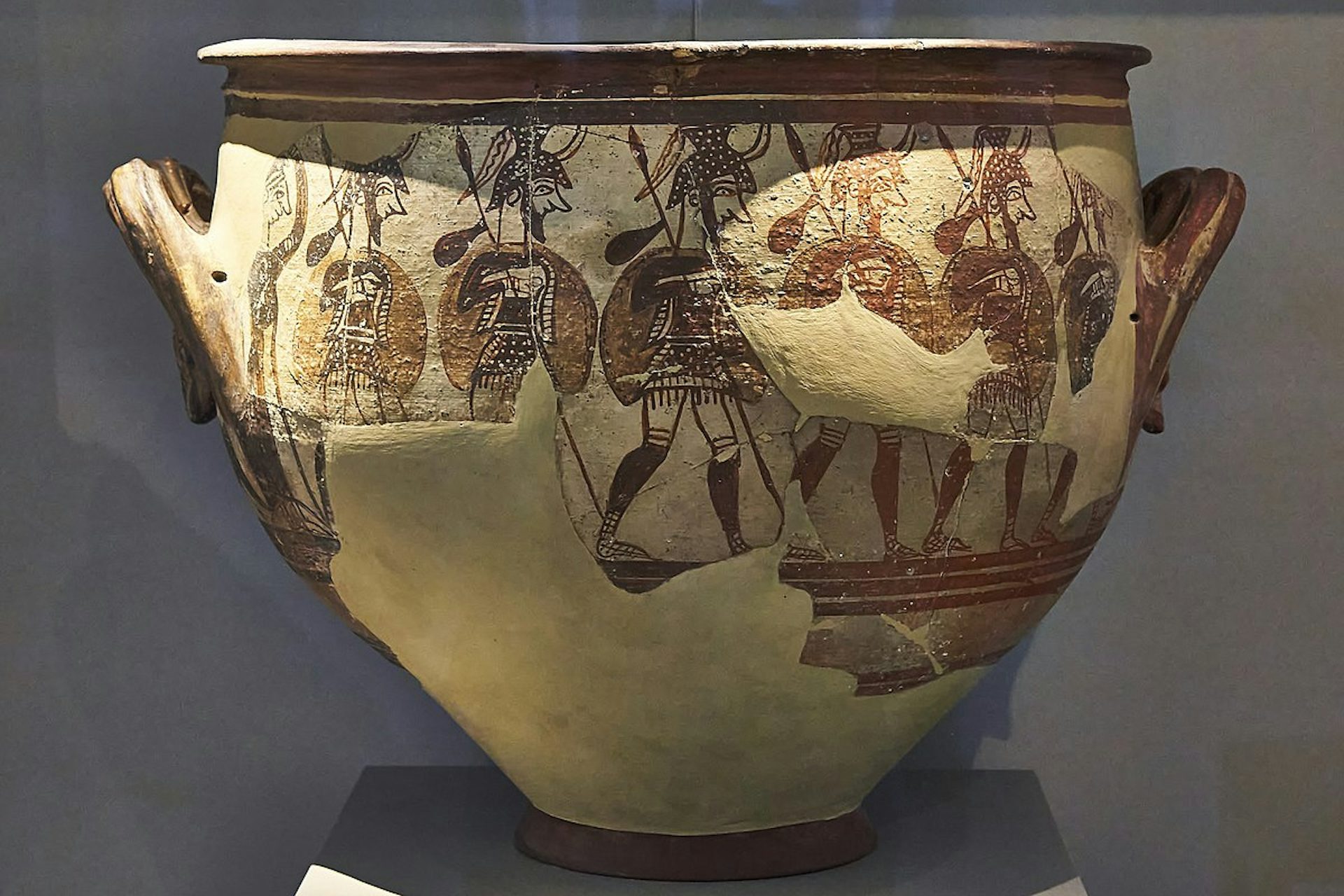
Mycenaean krater (mixing bowl) showing soldiers setting out for battle (12th century BCE)
National Archaeological Museum, Athens / George E. KoronaiosCC BY-SA 4.0Above all, the Odyssey appears to have been influenced by the increase in travel and colonization that marked the Archaic period of Greek history (ca. 800–490 BCE). Odysseus journeys to many distant and exotic lands, meeting strange people and creatures along the way—experiences that probably resonated with the poem’s early Greek audience, who were increasingly discovering other civilizations.
This increased contact no doubt led to foreign influences on the literature and mythology of the Greeks. Indeed, the Odyssey shows clear signs of Near Eastern influence. For example, Odysseus’ travels closely resemble those of the Mesoptomian hero Gilgamesh, who, like Odysseus, journeyed to the end of the world, consorted with goddesses, and visited the land of the dead.
Synopsis
Telemachus and the Telemachy (Books 1–4)
Book 1 of the Odyssey begins with an introduction to Odysseus and his absence. On Mount Olympus, the gods decide that it is time for Odysseus, who has been stranded for seven years on the island of the nymph Calypso, to finally return home. Athena, goddess of wisdom and Odysseus’ protector, goes to Odysseus’ palace in Ithaca, which is being overrun by unruly suitors who wish to marry Odysseus’ wife Penelope and take over the kingdom. Athena disguises herself and convinces Telemachus, Odysseus’ son, to go in search of his father.
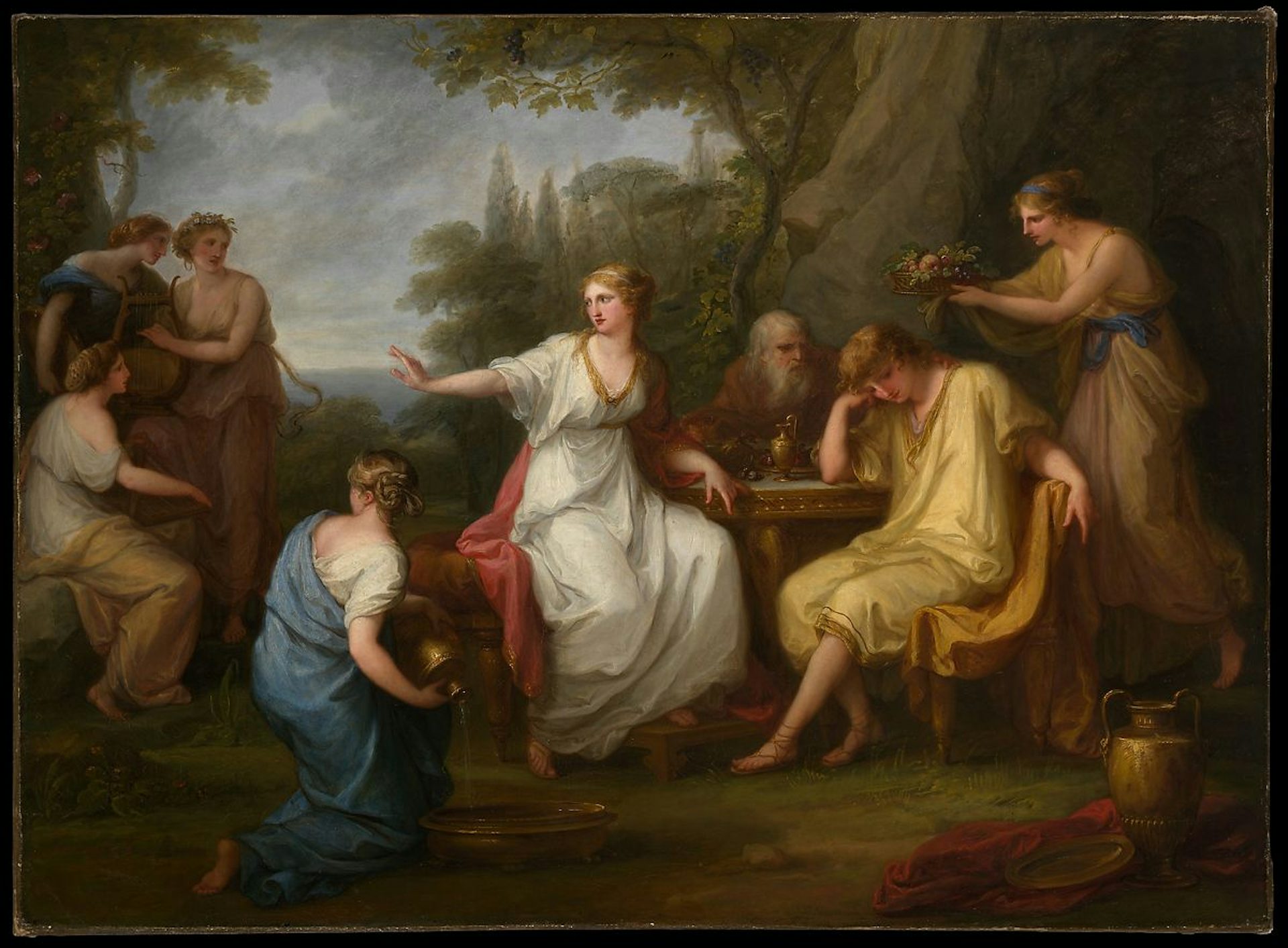
The Sorrow of Telemachus by Angelica Kauffmann (1783)
The Metropolitan Museum of ArtPublic DomainBook 1 of the Odyssey begins with an introduction to Odysseus and a discussion of his absence. On Mount Olympus, the gods decide that it is time for Odysseus, who has been stranded for seven years on the island of the nymph Calypso, to finally return home. Athena, goddess of wisdom and Odysseus’ protector, goes to Odysseus’ palace in Ithaca, which has been overrun by unruly suitors who wish to marry his wife Penelope and take over the kingdom. Athena disguises herself and convinces Telemachus, Odysseus’ son, to go in search of his father.
Odysseus, the Phaeacis, and the Apologoi (Books 5–12)
In Book 5, we finally meet Odysseus. Zeus sends Hermes, the messenger of the gods, to order Calypso to release Odysseus. The hero builds a raft and sets sail. But Poseidon, the god of the sea and Odysseus’ enemy, spots the hero and shipwrecks him.
Odysseus eventually washes ashore on Scheria, the island of the Phaeacians, where Athena arranges for him to be found by the princess Nausicaa (Book 6). With Nausicaa’s help, Odysseus arrives at the court of Alcinous and Arete, the king and queen of the Phaeacians (Book 7).

Odysseus and Nausicaa by Valentin Serov (1910)
Wikimedia CommonsPublic DomainThe Phaeacians entertain Odysseus, who does not initially reveal his identity (Book 8). Pressed by Alcinous, however, Odysseus finally tells the court who he is and begins recounting the story of his wanderings in Book 9.
Odysseus narrates his adventures after the fall of Troy, including his encounters with the Cicones, the lotus-eaters, and the terrifying Cyclops Polyphemus. He and his men manage to escape Polyphemus by blinding him in his one eye, but this earns Odysseus the hatred of Polyphemus’ father Poseidon.
Odysseus continues his story in the following books. He tells of further adventures with Aeolus (the lord of the winds), the man-eating Laestrygonians, and the sorceress Circe. Circe initially transforms several of Odysseus’ men into swine, but she eventually restores them to their original form and even grants hospitality to Odysseus and his companions (Book 10).
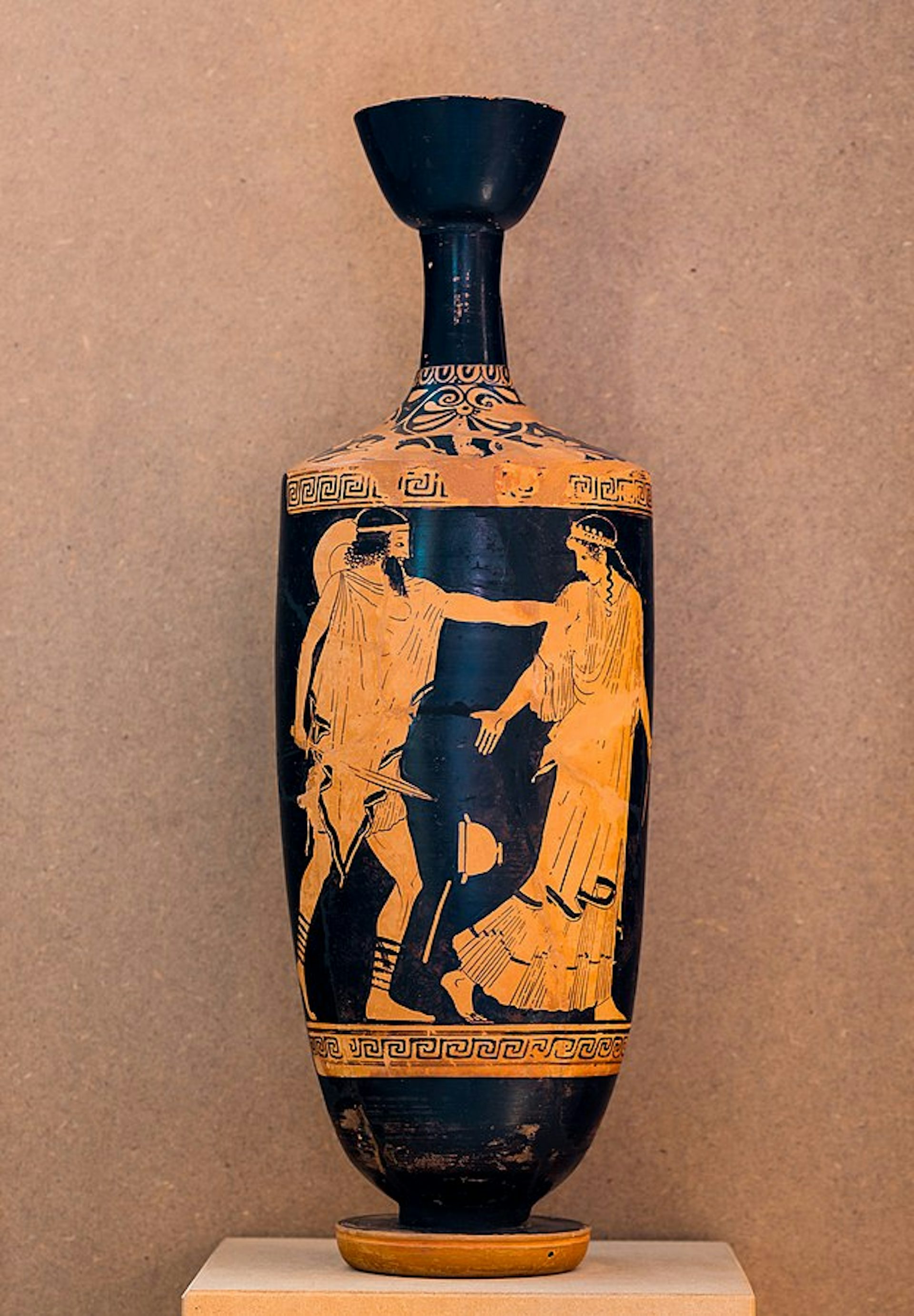
Attic red-figure lekythos (oil jar) showing Odysseus threatening Circe by the Nikon Painter (ca. 480–470 BCE)
Friedrich–Alexander University, Erlangen and Nuremberg / ArchaiOptixCC BY-SA 4.0In Book 11, Odysseus describes his journey to the Underworld to seek advice from the seer Tiresias.[4] While there, he meets many shades (spirits of the dead), including his warrior companions Achilles and Agamemnon and his mother Anticlea.
In Book 12, Odysseus tells of how he and his men managed to escape the Sirens and the sea monsters Scylla and Charybdis. But on the holy isle of Thrinacia, his men decide to devour the cattle of the sun god Helios and are killed in a storm as punishment. Odysseus, the sole survivor, washes ashore on Ogygia, where he is kept as Calypso’s lover for several years before traveling to Scheria.
The Return (Book 13–24)
After Odysseus finishes his tale, the Phaeacians give him lavish gifts, put him on a ship, and return him to Ithaca while he is sleeping (Book 13). In Ithaca, Odysseus is greeted by Athena, who disguises him as an old beggar so that he can go into the city without being recognized by the dangerous suitors.
Still dressed as a beggar, Odysseus is entertained by his old swineherd Eumaeus in Book 14, though he continues to lie about his identity. Telemachus, meanwhile, makes his way back home, meeting the seer Theoclymenus on the way and narrowly avoiding the ambush the suitors had set for him (Book 15). Upon reaching Ithaca, Telemachus stops at Eumaeus’ hut, where he is reunited with his father after twenty years (Book 16). The two begin to plot the destruction of the suitors.
In Book 17, Odysseus and Telemachus go to the palace separately. Odysseus, still disguised as a beggar, is viciously abused by the suitors (Books 17 and 18). At night, Odysseus and Telemachus hide all the palace’s weapons so the suitors cannot find them (Book 19). Odysseus speaks with his wife Penelope but does not reveal his identity to her. He is, however, recognized by his old nurse Euryclea, who is sworn to secrecy.
The next day, Odysseus and Telemachus—helped now by Eumaeus and another loyal slave, the cowherd Philoetius—continue their preparations to kill the suitors (Book 20). Penelope announces that she will marry whoever can string Odysseus’ great bow and shoot an arrow through twelve ax heads (Book 21). All the suitors try and fail. Odysseus then takes the bow and, of course, passes the test easily before slaughtering the suitors with the help of Telemachus, Eumaeus, and Philoetius (Book 22).
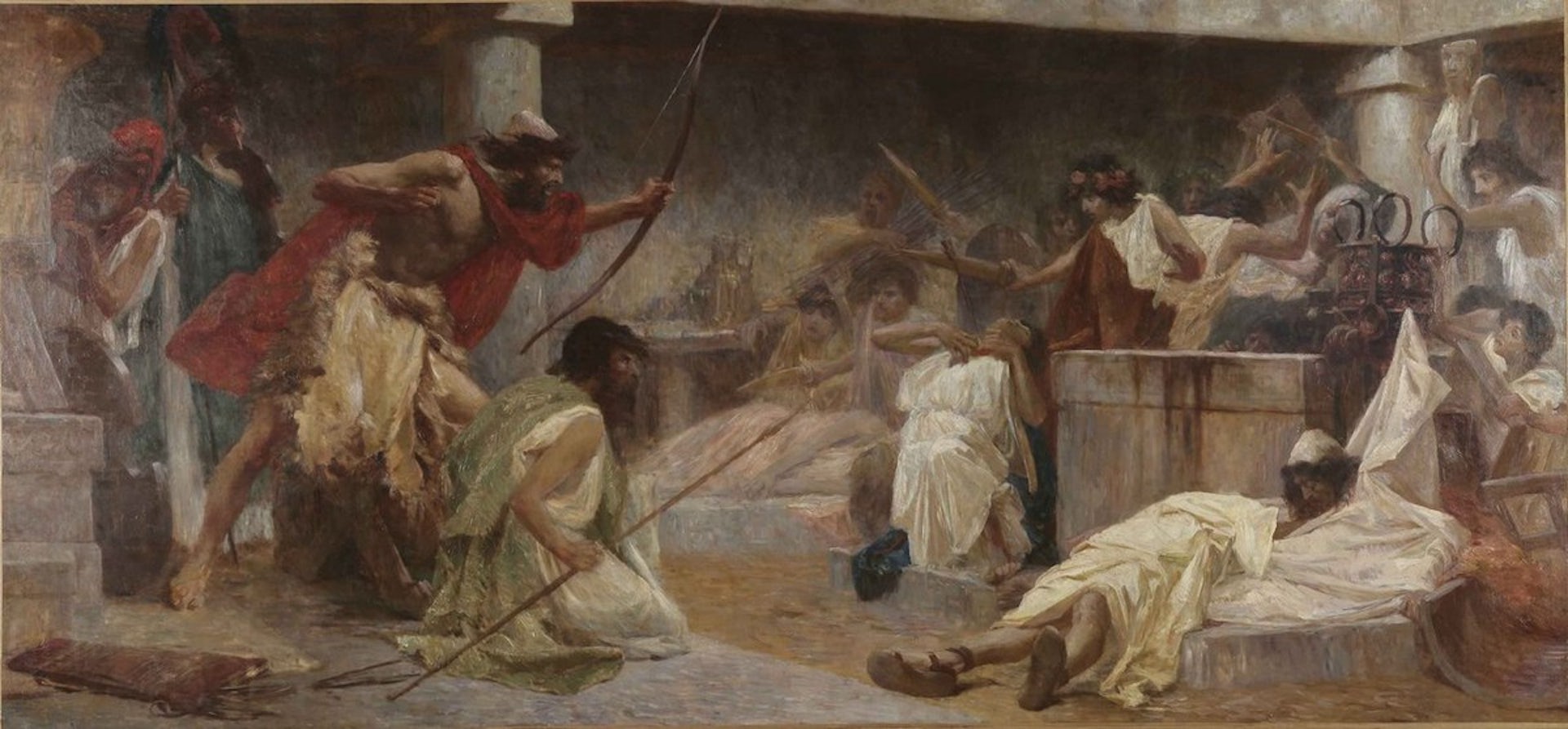
Odysseus Kills the Suitors by Bela Čikoš Sesija (early 20th century)
Wikimedia CommonsPublic DomainAfter the massacre is complete, Odysseus and Penelope are finally reunited (Book 23). The next morning (Book 24), Odysseus is also reunited with his elderly father Laertes. The angry families of the suitors prepare to attack Odysseus, but Athena swoops down to make peace.
Style and Composition
The Odyssey is generally believed to have been composed just after the Iliad, the other epic regarded as “Homeric.” Like the Iliad, the Odyssey typifies the basic conventions of early Greek epic poetry, employing dactylic hexameter and an elevated, artificial diction, which does not appear to have corresponded to any spoken dialect of ancient Greek. Stylistically, these epics are also notable for their use of elaborate speeches and similes.
Together with the Iliad, the Odyssey represents one of the earliest examples of written literature in ancient Greece; before the eighth century BCE, Greek poetry was composed and transmitted purely orally. In fact, the Odyssey (like the Iliad) probably originated as an oral poem and retains some of the formulaic elements that distinguished such poetry. However, because it was eventually written down, the Odyssey stands out as a remarkable example of the transition from orality to literacy in ancient Greece.
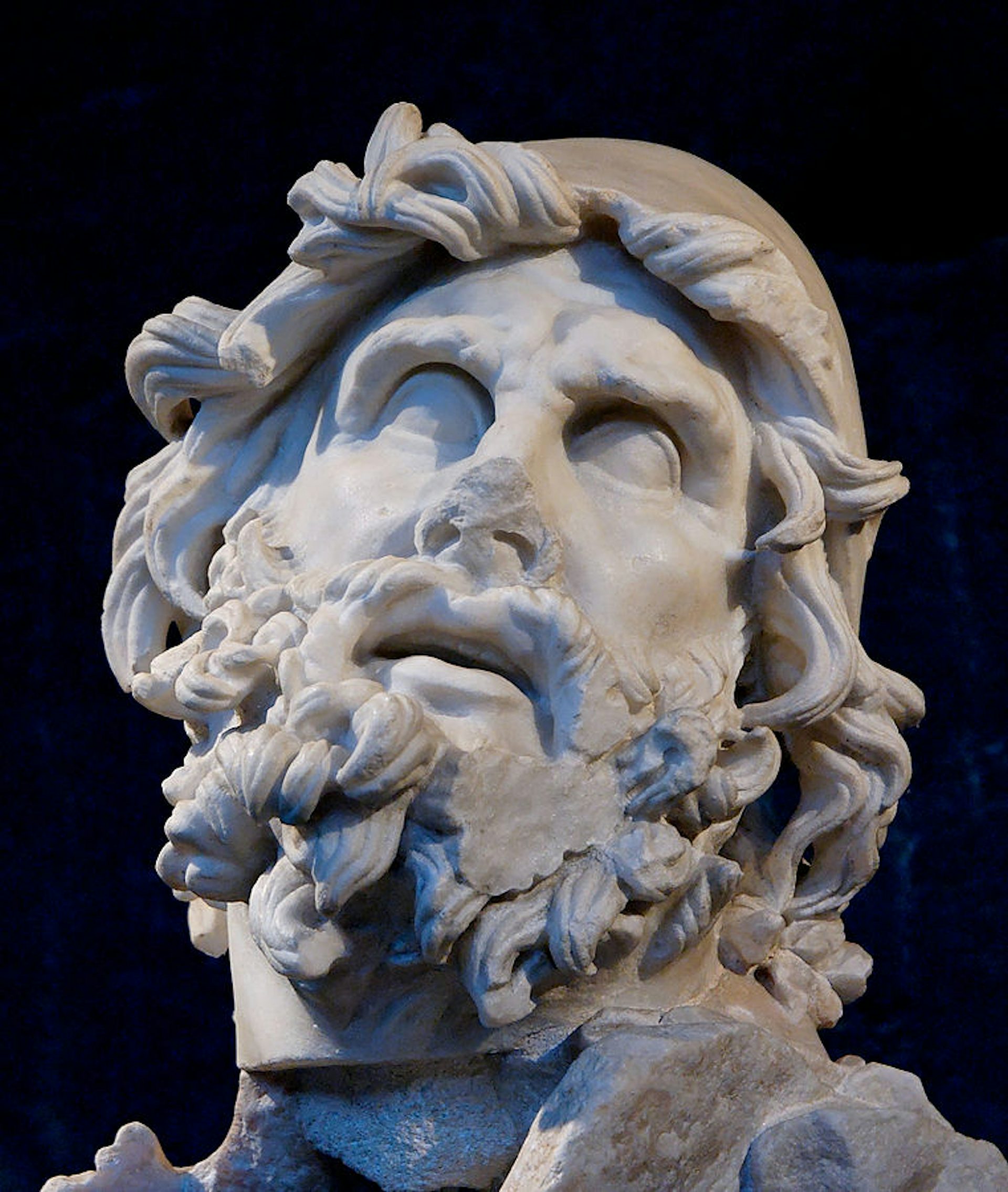
Head of Odysseus from a sculptural group showing the blinding of Polyphemus (1st century CE). From the Villa of Tiberius at Sperlonga.
National Archaeological Museum, Sperlonga / Marie-Lan NguyenPublic DomainThough the Iliad and the Odyssey have many similarities, there are also important stylistic differences between the two epics. For instance, there are fewer extended similes in the Odyssey, as well as greater thematic “variety” (poikilia). Such differences may reflect gradual developments in early Greek literature, but they also lend credence to the theory—accepted by most scholars today—that the two epics were not written by the same poet.
Themes
The Odyssey explores an astonishing variety of themes, including heroism, duty, family, gender, and the relationship between gods and mortals. These themes are all filtered through the main subject of the Odyssey: the homecoming (nostos) of the hero Odysseus. This is announced in the very first lines:
Tell me, O Muse, of the man of many devices, who wandered full many ways after he had sacked the sacred citadel of Troy. Many were the men whose cities he saw and whose mind he learned, aye, and many the woes he suffered in his heart upon the sea, seeking to win his own life and the return of his comrades. Yet even so he saved not his comrades, though he desired it sore, for through their own blind folly they perished—fools, who devoured the kine of Helios Hyperion; but he took from them the day of their returning. Of these things, goddess, daughter of Zeus, beginning where thou wilt, tell thou even unto us.[5]
The Odyssey weaves through different worlds as it follows the return journey of Odysseus, leading us to reflect on the value of human life and civilization. We encounter numerous fantastical lands and creatures in Odysseus’ narrative of his travels. These are contrasted with the “real” world of Ithaca, Pylos, and Sparta—a world that contains suffering, death, and war, but that is also defined by order and rules that must be obeyed.
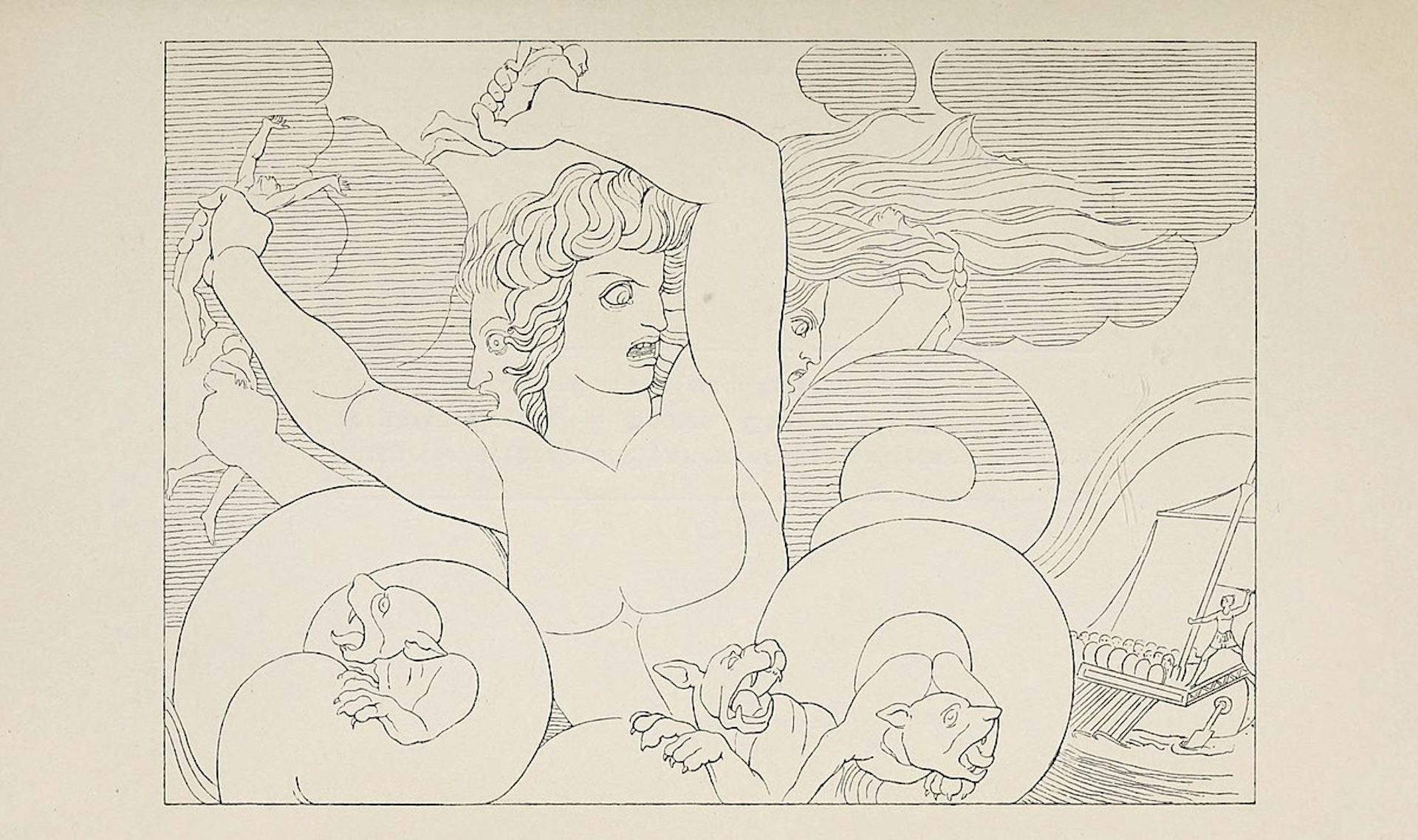
Illustration of Scylla attacking Odysseus and his crew by John Flaxman (1910)
Wikimedia CommonsPublic DomainThe real world, for all its flaws, is the only place where mortals like Odysseus can find happiness, community, and family. This is why Odysseus turns down Calypso when she offers to make him immortal if he will only forget Ithaca and stay with her on Ogygia (Book 5). It is also why Achilles’ shade tells Odysseus in the Underworld that
“I should choose, so I might live on earth, to serve as the hireling of another, of some portionless man whose livelihood was but small, rather than to be lord over all the dead that have perished.”[6]
In order for the civilized human world to function properly, however, certain rules must be obeyed, and the punishment for violating those rules is severe. The lawless suitors, for example, who try to steal Odysseus’ wife and property, are wiped out in the end.
The gods, too, must be obeyed, but even they are subject to a hierarchy, with each god ruling over their own domain and Zeus ruling over all. Poseidon can do whatever he wants with Odysseus while he is at sea—even Athena cannot step in—but in the end, Poseidon must bow to the will of Zeus when he decides it is time for Odysseus to return home.
The Odyssey is also a poem about heroes and heroism, not unlike the Iliad. But Odysseus is a very different kind of hero from Achilles, the Iliad’s protagonist. Though both are great warriors, Odysseus is more approachable than Achilles. He is, as the very first word of the Odyssey declares, a “man.” Throughout his epic, Odysseus’ chief goal is not military glory (kleos) but simply to go home to his family. While Achilles’ heroism lies primarily in his superiority as a fighter, Odysseus never shies away from using cunning to get his way. Odysseus also typifies the qualities of endurance and self-control far more effectively than the impulsive Achilles.
While the heroism of the Odyssey is defined by noble male figures, slaves and women also play an important role in this sprawling epic. Penelope is shown to be the intellectual equal of her famously intelligent husband, using her cunning not only against the suitors but also, in Book 23, to test Odysseus himself. Penelope is also the epic’s paragon of female virtue, though this ultimately means she is largely defined by her relationships to men (she is the wife of Odysseus, the mother of Telemachus, the daughter of Icarius, etc.). Indeed, her most notable virtue is her stalwart marital fidelity to Odysseus.
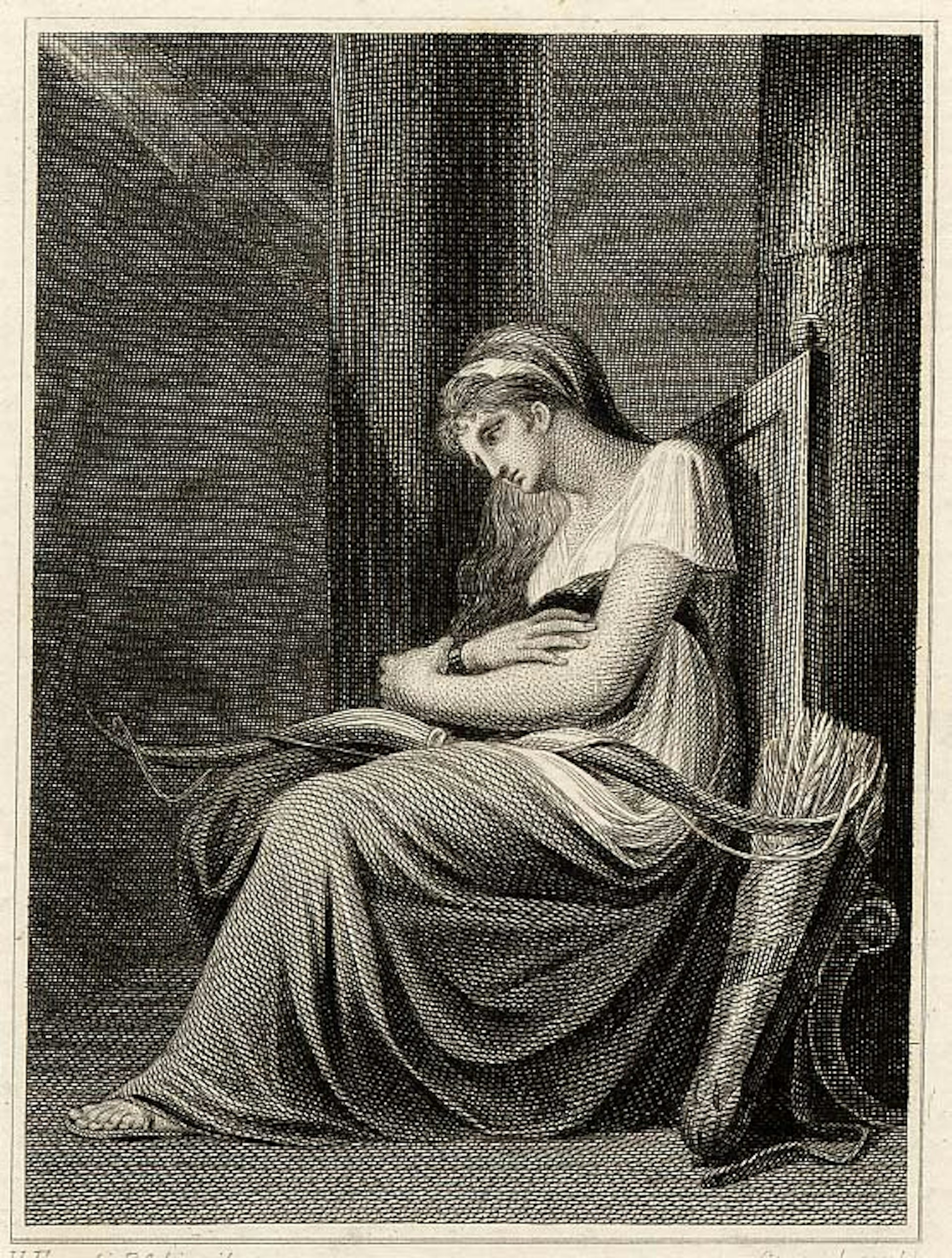
Penelope Holding the Bow of Odysseus by Robert Hartley Cromek after Henry Fuseli (1806)
British MuseumPublic DomainThroughout the epic, Homeris often remarkably metaliterary or metapoetic; in other words, the Odyssey embeds numerous sub-narratives within the overarching frame narrative. Some of these are told by poets such as Phemius (Book 1) or Demodocus (Book 8), but the most famous internal narrative comes from Odysseus himself, whose story spans four books of the Odyssey. The Odyssey is thus a sophisticated meditation on the nature of storytelling and poetry.
Reception
Antiquity
The impact of Homer’s poems cannot be overestimated. The Iliad and the Odyssey have been essential to Greek cultural and religious identity practically since their inception, and they exerted a huge influence on the Romans as well. These texts became the basis for all subsequent hexameter and elegiac poetry; all ancient epics, from Apollonius of Rhodes’ Argonautica to Virgil’s Aeneid to Nonnus’ Dionysiaca, were in some way a response to Homer. Homer was also central to the development of ancient drama, with Aeschylus reportedly describing his own tragedies as “crumbs from Homer’s feast.” Indeed, many have dubbed Homer the father of tragedy.
Already in antiquity, the Odyssey was influencing individual poems as well as whole genres (such as the Alexandrian novels, which became popular in the first century CE). The Odyssey also played a formative role in Latin literature; Livius Andronicus’ Latin translation of the Odyssey around 241 BCE is widely cited as the first true work of Latin literature. Scenes from the Odyssey were extremely popular in ancient art as well.
Medieval, Renaissance, and Early Modern Europe
During the Middle Ages and Renaissance, the Iliad and the Odyssey became the heart of the Western literary and artistic canon. Numerous translations and adaptations of the Odyssey were produced during this period. In Dante Alighieri’s Inferno, for example, the narrator meets Odysseus in the eighth circle of Hell.
The Odyssey continued to influence later European literary figures, including William Shakespeare, John Milton, and Alfred Tennyson. More recently, James Joyce’s novel Ulysses (1922) reworked the narratives and themes of the Odyssey in a modern context. In 1938, the Greek author Nikos Kazantzakis published his masterful epic Odyssey: A Modern Sequel, which picks up the story of Odysseus where Homer left off.
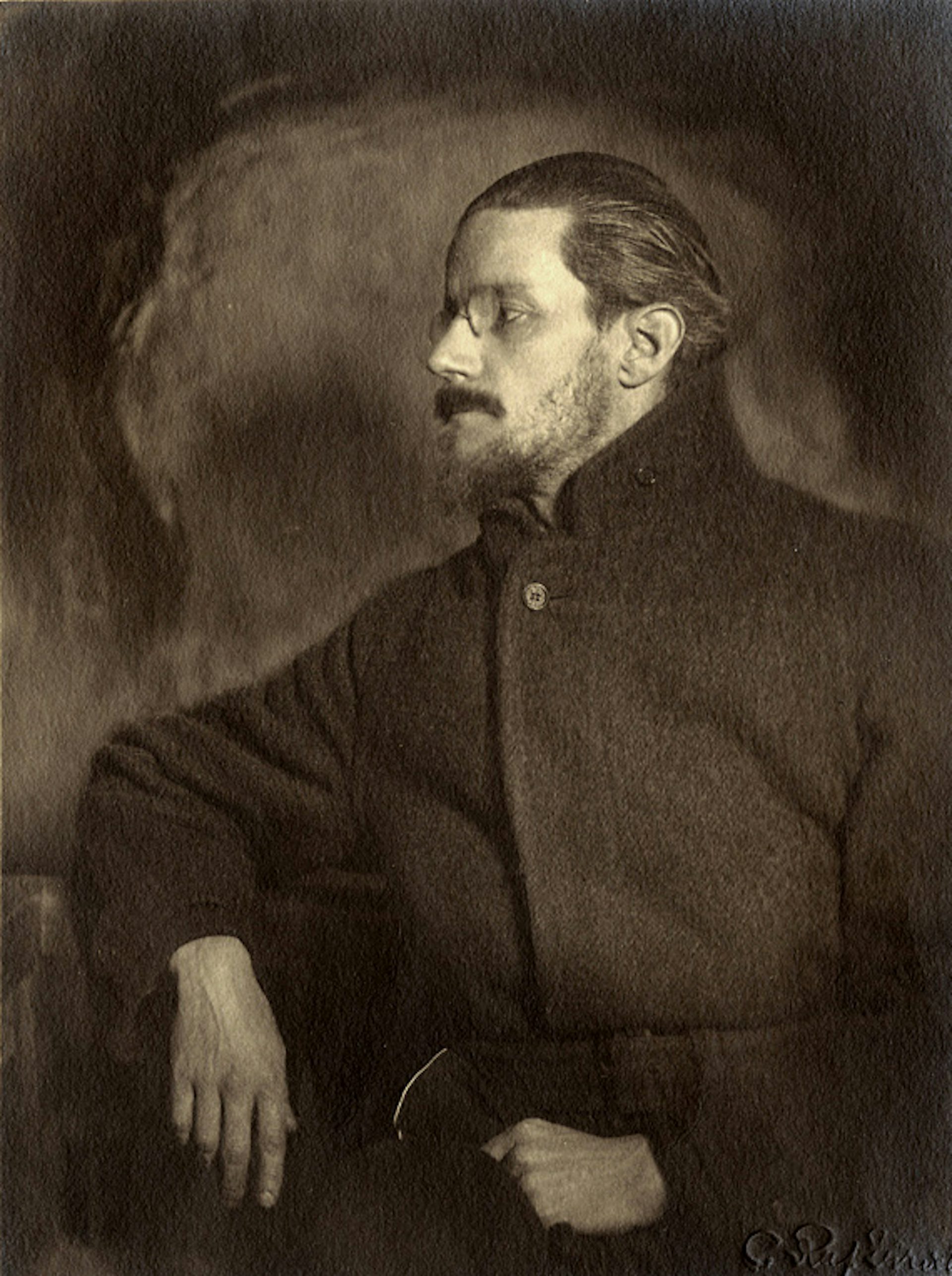
James Joyce, photographed in Zurich by Camille Ruf (ca. 1918)
Wikimedia CommonsPublic DomainScenes from the Odyssey have also captured the imagination of artists such as Jacques-Louis David, Jean-Auguste-Dominique Ingres, William Theed the Elder, and many more.
Pop Culture
The Odyssey remains prominent in contemporary pop culture. It has inspired numerous works of literature, including novels by Margaret Atwood and Madeline Miller. It has also been adapted into films, miniseries, and TV shows, among them the 1954 film Ulysses and the 1997 miniseries The Odyssey.
Translations
There have been numerous English translations of Homer’s Odyssey, many of them dating back hundreds of years. The following is a selected chronological list of important and useful translations:
Pope, Alexander, trans. The Odyssey of Homer. London: Bowyer, 1725: A fluid translation of the Odyssey in rhyming couplets. Still popular today, though known to contain many artistic liberties and inaccuracies.
Butler, Samuel, trans. The Iliad of Homer. London: Longmans, Green, and Co., 1900: An old prose translation of the Odyssey, still widely known and used today.
Murray, A. T., trans. Homer: Odyssey. 2 vols. Loeb Classical Library 104–5. Cambridge, MA: Harvard University Press, 1919: An old-fashioned, literal translation. Useful, but not the most readable. Revised by George E. Dimock and reprinted in 1995.
Rieu, E. V., trans. Homer: The Odyssey. London: Penguin, 1946: Prose translation; somewhat formal and dated.
Fitzgerald, Robert, trans. The Odyssey. New York: Doubleday, 1961: An elegant literary translation in blank verse. Popular, but with some creative liberties. Reprinted by Farrar, Straus, and Giroux in 1998.
Lattimore, Richmond, trans. The Odyssey of Homer. Chicago: University of Chicago Press, 1965: Verse translation in a meter very close to Homer’s original dactylic hexameter. Still highly regarded and very true to the original. Reprinted in 2002.
Fagles, Robert, trans. Homer: Odyssey. New York: Viking, 1996: Very modern, readable, and fast-paced verse translation. Popular with general readers and undergraduates.
Hammond, Martin, trans. Homer: The Odyssey. London: Duckworth, 2000: Clear, accurate prose translation.
Lombardo, Stanley, trans. The Odyssey.Hackett Classics. Indianapolis: Hackett, 2000: Accurate and accessible verse translation.
Merrill, Rodney, trans. Homer: The Odyssey. Ann Arbor: University of Michigan Press, 2002: Musical translation written in dactylic hexameter, the same verse employed in the original.
Powell, Barry, trans. Homer: The Odyssey. Oxford: Oxford University Press, 2014: Accurate verse translation, though regarded as somewhat prosaic at times.
Wilson, Emily, trans. Homer: The Odyssey. New York: Norton, 2017: Well-received verse translation. The first translation of the Odyssey completed by a woman.
Green, Peter, trans. The Odyssey. Berkeley: University of California Press, 2018: Lively, often colloquial translation that remains accurate to the original.